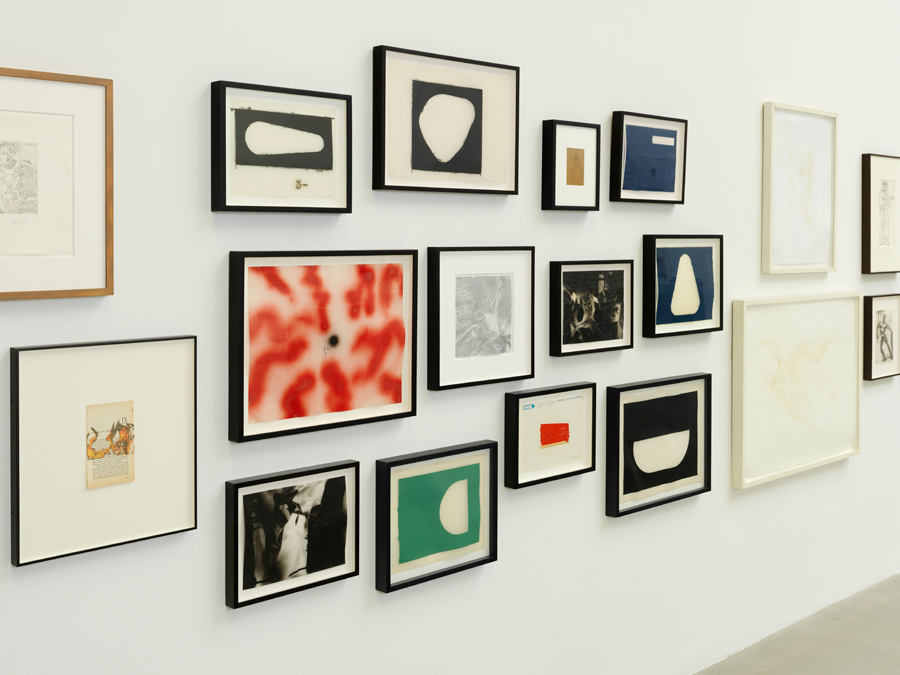Olympia
Galerie Patrick Seguin, Paris, France
Galerie Patrick Seguin, Paris, France

Seven plinths of books from Richard Prince’s series ‘American/English’ (2005–09) stand sentry. Inside the gallery, the 187 works on paper by 54 artists make up ‘Olympia’, which was curated by Brendan Dugan of Karma in New York as part of Galerie Patrick Seguin’s ‘Carte Blanche’ annual invitation programme. Prince’s podiums comprise Anglo-American editions of books, including Edna O’Brien’s August Is a Wicked Month (1965) and J. G. Ballard’s Crash (1973), and serve as a reminder of the show’s literary theme.
‘Olympia’ takes its title from The Olympia Press, the publisher of erotic and avant-garde fiction that put out books by Samuel Beckett, William S. Burroughs, Henry Miller, members of the Beat Generation and, most famously, Vladimir Nabokov’s Lolita (1955). When faced with the task of christening his newborn venture in 1953, Olympia’s founder, Maurice Girodias, took inspiration from the eponymous painting by Édouard Manet, which had appalled so many viewers in 1863.

It’s inevitable that none of the works featured here are as provocative today as they were when they were first created. (One exception is Lee Lozano’s tough drawings from the 1960s of hand tools emblazoned with slogans such as: ‘Eat cunt for mental health.’) That said, the juxtapositions produce weird and wonderful contrasts: Mark Grotjahn’s Untitled (After Martin ‘Do They Think I am a S. O. Bee?’) (2006), Sarah Lucas’s FIVE LISTS (1991) and Ken Price’s quasi-phallic Mexican Style Civic Sculpture (2007) all tease out the notion of the profane. John Currin’s coyly titled Sans Pants (2014) and Nolan Hendrickson’s smutty caricatures on graph paper (2016) provide cool respite from some of the more heavy-handed approaches to the depiction of sex, nudity and erotica.
In the introduction to The Olympia Reader (the out-of-print anthology published by Grove Press in 1965), Girodias wrote that in the work of Burroughs, Miller and Alexander Trocchi – as well as in the list of less literary ‘d.b.s’, or dirty books – ‘the Anglo-Saxon world was being attacked, invaded, infiltrated, out-flanked and conquered by this erotic armada’. No such force greets visitors to this show: the censorship that caused such difficulties for Girodias and Manet is, of course, more relaxed today. Provocation is cast aside by the irreverent ethos with which these drawings and works are exhibited. Washes of candy colours overlaying Sigmar Polke’s Untitled (Couple) (1973) are anticipated by two of Stanley Whitney’s gouache grids from 2015, and give these apparently abstract works a sensual charge. Robert Crumb’s Untitled, 2002, Page from ‘Art & Beauty Magazine, Number 2’ (2003) is adjacent to an 1867 etching by Manet of the painting Olympia itself: these are just two of the many depictions of the reclining female body that are interspersed throughout the show.
There are tender moments, too: the crimson tints in Louise Bourgeois’s COUPLE (2009) and PREGNANT WOMAN (2008) provide a beating heart among the more prosaic depictions of sex. And a series of sex acts drawn on prison roster sheets by the mysterious artist William Crawford – whose drawings from the 1990s were discovered in an abandoned house in Oakland, California – are a poignant example of what transgression can be.

The breadth of ‘Olympia’ is exceptional – has Andy Warhol’s Fellatio (1956) ever been shown alongside Pablo Picasso’s etchings of Raphael and La Fornarina, or Willem de Kooning’s Seated Woman (c.1938–40) next to Ed Ruscha’s Sex (1991)? Yet, it’s the work of younger artists such as Will Boone, Caitlin Keogh and Spencer Sweeney that makes Olympia feel so fresh.
Erotic art today doesn’t emanate the sense of abandon that lay behind the Olympia Press’s activities, or the epoch-shifting power of Manet’s unblinking nude. But issues of restraint and transgression remain open-ended and so ‘Olympia’ the exhibition is a fitting tribute to dirty work – then and now.























